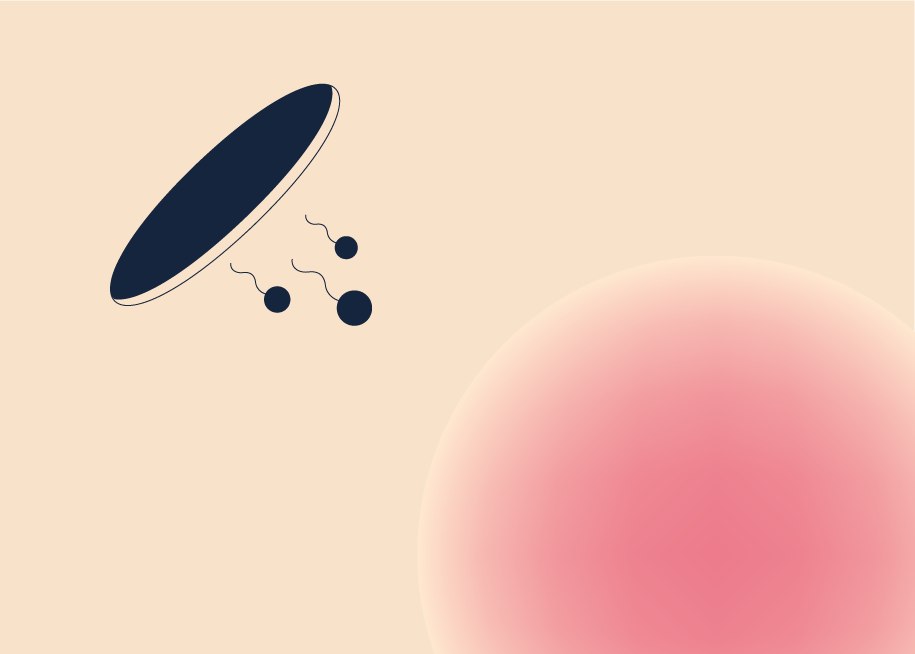If you menstruate, you probably know that it's all centered around your ovaries releasing an egg every month. For many people, however, eggs themselves might be a bit of a mystery.
Your eggs are microscopic, but that doesn't mean they don't play a big role in your reproductive system and fertility. There is also a lot that goes into how healthy they are. Let's break down the role your eggs play in ovulation, factors that can affect your egg's health, and some common myths.
Ovulation and your eggs
Ovulation happens when an egg is released from the ovary into the fallopian tubes, where it may or may not be fertilised by sperm. This process usually happens around day 14 of your menstrual cycle. However, this is assuming you have a 28-day cycle, which not everyone has (1). In fact, cycles that last from 21 to 40 days are also considered normal, so the timing of ovulation often varies from person to person. If the egg is fertilised, it travels to your uterus to implant itself, and pregnancy occurs.
You may ovulate more than one egg at a time. This can happen during fertility treatments as well as due to hormone medications. If it occurs, you may become pregnant with twins or more.
You can only get pregnant on the day you ovulate and five days prior, known as the fertile window. This means there are only six days per cycle where you can get pregnant (3).
How does ovulation work?
At the beginning of your cycle, around day 5, your ovaries will start to mature its biggest follicles, which are small pockets of fluid that contain an egg (4). Over the next several days, one follicle continues to grow while the others break down in a process known as atresia.
Your body then releases a hormone called follicle-stimulating hormone (FSH) over the next few days. FSH helps the egg to finish maturing for its release from the follicle. When this maturation happens, your body will release luteinizing hormone (LH) which tells the egg to release from the follicle. After this LH surge, ovulation can happen in 24-36 hours (5).
After it's released from the ovary, an egg is available to be fertilised for 12-24 hours. Sperm can live for up to five days in your uterus and fallopian tubes, so if you had sex 5 days before ovulation or on the day itself, you could get pregnant (4). If the egg isn’t fertilized, it breaks down and is shed along with your uterine lining. After an egg is released from a follicle during ovulation, the corpus luteum, which is what’s leftover after the follicle ruptures, releases progesterone, a hormone that helps the uterine lining thicken up in case pregnancy occurs. Progesterone also helps to support successful implantation of the fertilized egg.
The life cycle of your eggs
Before you were born, you already had all the eggs you are ever going to use in your lifetime—about 1 to 2 million of them. Unlike males, your body doesn't make new eggs throughout your life. Sperm, however, are constantly being replenished. By the time you hit puberty, only about 300,000 to 500,000 eggs remain. By age 37, you will only have about 25,000 eggs remaining (6). For most females, fertility begins to decline around the age of 32. This has to do with the number of remaining eggs, but also with the quality of those eggs.
As you get older, so do your remaining eggs, and this aging causes them to start decreasing in quality (7). This means they can become genetically abnormal, a process that happens at the level of the chromosomes. Older eggs are more likely to have problems when dividing and growing, leading to these abnormalities. Chromosomally abnormal eggs can potentially become abnormal embryos, leading to a higher chance of miscarriage (8).
What affects egg health?
Age isn't the only thing that affects your eggs. Outside factors in your environment as well as lifestyle choices can have a significant impact on ovulation and egg quality. These can include (9):
-
Exposure to toxins
-
Smoking or drug use
-
Caffeine intake
-
Being overweight or obese, or underweight
You can do a few things to protect the quality of your eggs, such as eating a diet of fresh fruits and vegetables, lean proteins, and healthy fats; getting daily exercise; and maintaining a healthy weight. Try to avoid heating plastics in the microwave and dishwasher, because this can release toxins into the foods you’re eating (10). As much as possible, use clean household and beauty products, to avoid exposure to any harmful chemicals, such as the carcinogen formaldehyde, and phthalates which are known to cause reproductive harm (11).
There's some thought that women who are obese might have issues with their ovaries such as not ovulating at all, or hormone imbalances causing fertilized embryos to not develop properly (12). This can lead to premature ovarian failure (POF) meaning the ovaries stop releasing eggs before you reach 40 years old. Hormones can greatly affect your egg quality, which is why hormones and your eggs can go hand in hand.
If you smoke, now is a great time to quit, as well as any recreational drug use. There's evidence that smoking can cause damage to your eggs (13).
Myths about eggs and ovulation
Myth: Your ovaries alternate releasing eggs on each side
You can alternate what side you ovulate on every month, but it doesn’t always happen that way. Ovulation occurs when one of your follicles matures enough to release an egg and it doesn't matter which side this happens on. Actually, many women find they ovulate from one side more often than the other. An older study from 2000 showed women actually ovulate more on the right ovary than the left (14).
Myth: As long as you're ovulating, you won't have trouble getting pregnant
Actually, there's a lot more to getting pregnant than an egg being released from the follicle. Sometimes your Fallopian tubes can be blocked which means the egg can't get to the uterus to implant. There can also be concerns with sperm that make it harder to fertilise an egg, such as a low or no sperm count. Other conditions, such as endometriosis, can affect fertility that aren’t directly related to your eggs. Endometriosis is a common condition where uterine tissue grows outside of the uterus, causing pain and possibly infertility. Polycystic ovary syndrome (PCOS) is another condition caused by an imbalance of reproductive hormones. It causes fluid-filled sacs called cysts to form on the ovaries and can cause fertility concerns.
Myth: Not everyone ovulates on day 14 of their cycle
Your cervical mucus changes in consistency depending on where you're at in your menstrual cycle. You might track your basal body temperature to detect rises in temperature when you're ovulating. But sometimes it can be complicated using trackers and ovulation predictor kits. Of course, if you didn't ovulate that month, it's going to understandably be difficult finding the signs of ovulation. It’s hard to know for sure if you’re ovulating unless you track it or have an ultrasound to confirm.
Our reproductive systems can be complex. It can even be a little stressful, when you're trying to figure out if your body is doing “what it's supposed to,” or if you're trying to track symptoms for a diagnosis - or if you want to become pregnant. In using the inne minilab, you can be equipped to find your fertile window and monitor any progesterone hormone changes, through a simple, daily saliva test. The minilab’s smart algorithm learns your cycle and your hormonal patterns to predict and confirm ovulation. Unlike LH tests or ovulation kits that can only predict when ovulation might occur, the inne minilab also detects the rise in progesterone that occurs immediately after ovulation, confirming if it has taken place. The inne app also allows you to log observations about cervical fluids and symptoms, to better keep track of your menstrual cycle and any changes between cycles. Using inne can also help you to identify if there are any irregularities within or between cycles or around ovulation. Talk to your healthcare provider if you think you have concerns about your cycle or ovulation.
References
-
“Periods and Fertility in the Menstrual Cycle.” NHS Choices, NHS, 5 Aug. 2019, www.nhs.uk/conditions/periods/fertility-in-the-menstrual-cycle/.
-
Baerwald, A., Adams, G., & Pierson, R. (2003). A new model for ovarian follicular development during the human menstrual cycle. Fertility And Sterility, 80(1).
-
“Ovulation Calculator.” Office on Women's Health, 23 Jan. 2019, www.womenshealth.gov/ovulation-calculator.
-
“About Menstruation.” Eunice Kennedy Shriver National Institute of Child Health and Human Development, U.S. Department of Health and Human Services, 31 Jan. 2017, www.nichd.nih.gov/health/topics/menstruation/conditioninfo.
-
Hoff JD, Quigley ME, Yen SS. Hormonal dynamics at midcycle: a reevaluation (1983). J Clin Endocrinol Metab. 57, 792–796.
-
American College of Obstetricians and Gynecologists. (2014). Female age-related fertility decline. Fertility and Sterility 101(3), pp.633-634.
-
Steiner, A. and Jukic, A. (2016). Impact of female age and nulligravidity on fecundity in an older reproductive age cohort. Fertility and Sterility, 105(6), pp.1584-1588.e1.
-
“Early Pregnancy Loss.” American College of Obstetricians and Gynecologists, Aug. 2015, www.acog.org/womens-health/faqs/early-pregnancy-loss.
-
Sharma, R., Biedenharn, K. R., Fedor, J. M., & Agarwal, A. (2013). Lifestyle factors and reproductive health: taking control of your fertility. Reproductive biology and endocrinology. 11(66).
-
“Is Plastic a Threat to Your Health?” Harvard Health, 1 Dec. 2019, www.health.harvard.edu/staying-healthy/is-plastic-a-threat-to-your-health.
-
Hauser, R., Gaskins, A., Souter, I., Smith, K., Dodge, L., & Ehrlich, S. et al. (2016). Urinary Phthalate Metabolite Concentrations and Reproductive Outcomes among Women Undergoing in VitroFertilization: Results from the EARTH Study. Environmental Health Perspectives, 124(6), 831-839.
-
Dağ, Z. Ö., & Dilbaz, B. (2015). Impact of obesity on infertility in women. Journal of the Turkish German Gynecological Association, 16(2), 111–117.
-
Wang, N., et al. Fertility and Sterility. (2012). Smoking and infertility: a committee opinion. 98(6), pp.1400-1406.
-
Fukuda, M., Fukuda, K., Andersen, C. Y., & Byskov, A. G. (2000). Right-sided ovulation favours pregnancy more than left-sided ovulation. Human reproduction (Oxford, England), 15(9), 1921–1926.









